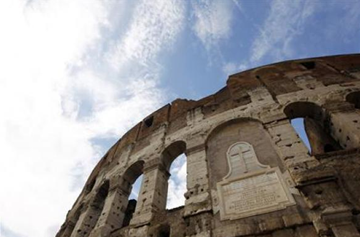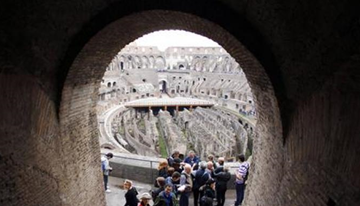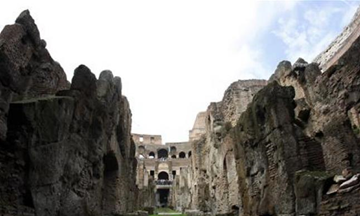Underground dungeons at Rome's Colosseum, considered to be one of the great feats of Roman architecture and where gladiators once locked in mortal combat, will open to the public for the first time next week.
 An upper area of the ancient monument that had been closed since the 1970s will also be accessible to visitors and offer them a view over Rome's ancient forum, Italian culture ministry officials said on Thursday. The opening of the underground chambers, where lions and tigers were caged and gladiators waited to hear their fate, and the upper third tier of the 80 A.D. Roman amphitheatre follows recent restoration work.
An upper area of the ancient monument that had been closed since the 1970s will also be accessible to visitors and offer them a view over Rome's ancient forum, Italian culture ministry officials said on Thursday. The opening of the underground chambers, where lions and tigers were caged and gladiators waited to hear their fate, and the upper third tier of the 80 A.D. Roman amphitheatre follows recent restoration work.
 "It is the first time people will have the chance to go down into the places where games and shows were organized," Rossella Rea, director of the Colosseum, said. Officials said the idea was also to give visitors more space at one of Italy's most visited monuments which in Roman times was the scene for mock sea battles, pitting warriors against wild animals and re-enactment of famous battles.
"It is the first time people will have the chance to go down into the places where games and shows were organized," Rossella Rea, director of the Colosseum, said. Officials said the idea was also to give visitors more space at one of Italy's most visited monuments which in Roman times was the scene for mock sea battles, pitting warriors against wild animals and re-enactment of famous battles.
 Rea said that more than 18,000 people come to see the amphitheatre every day and conditions had become cramped for visitors. The newly opened areas will be accessible to guided tours of a maximum of 25 people at a time. From the Porta Libitina - the "Gate of Death" through which the bodies of the dead were carried outside the amphitheatre - visitors will enter the "bowels" of the Colosseum. There gladiators once prepared for battle, and animals were caged before being transported by lifts up to the central fighting arena.
Rea said that more than 18,000 people come to see the amphitheatre every day and conditions had become cramped for visitors. The newly opened areas will be accessible to guided tours of a maximum of 25 people at a time. From the Porta Libitina - the "Gate of Death" through which the bodies of the dead were carried outside the amphitheatre - visitors will enter the "bowels" of the Colosseum. There gladiators once prepared for battle, and animals were caged before being transported by lifts up to the central fighting arena.
Visitor Safety
Underground since the 5th century, the dungeons are in good condition, officials said, unlike some open-air areas of the monument that have been exposed to tourists and rain.
 Built by the Roman emperor Vespasian, the amphitheatre could seat 50,000 spectators who would gather to watch gladiatorial contests and sometimes executions. The upper third tier was used to work the sails that provided shade for the spectators.
Built by the Roman emperor Vespasian, the amphitheatre could seat 50,000 spectators who would gather to watch gladiatorial contests and sometimes executions. The upper third tier was used to work the sails that provided shade for the spectators.
 The Colosseum, which was visited by about 4.5 million people in the first eight months of 2010, is in a sorry state and before the re-opening of the new areas, only 35 percent of the monument was accessible to visitors. Earlier this year, falling chunks of mortar plunged through a protective netting, rekindling the debate about visitors' safety at the monument and, more generally, the state of Italy's archaeological treasures. In July, the culture ministry said it was looking for private sponsors to plug a 25 million euro gap in funding for restoration and clean-up work.
The Colosseum, which was visited by about 4.5 million people in the first eight months of 2010, is in a sorry state and before the re-opening of the new areas, only 35 percent of the monument was accessible to visitors. Earlier this year, falling chunks of mortar plunged through a protective netting, rekindling the debate about visitors' safety at the monument and, more generally, the state of Italy's archaeological treasures. In July, the culture ministry said it was looking for private sponsors to plug a 25 million euro gap in funding for restoration and clean-up work.
Authors: Cristiano Corvino, Gabriele Pileri & Eleanor Biles | Source: Reuters [October 14, 2010]